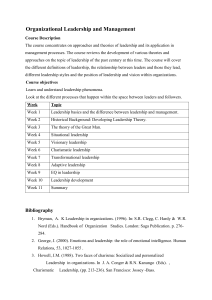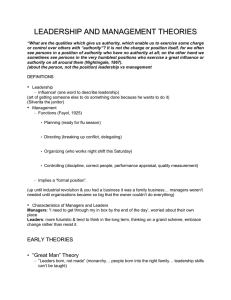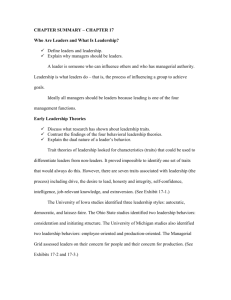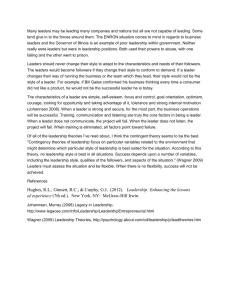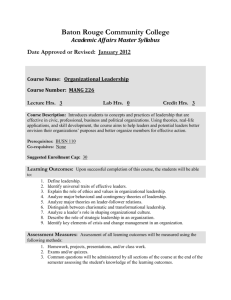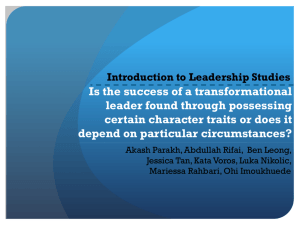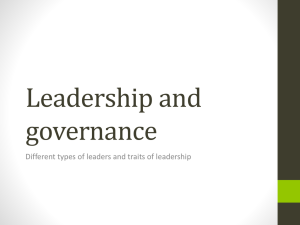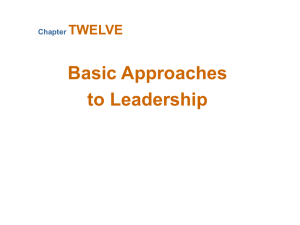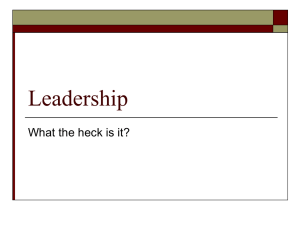Organizational Behavior 10e
advertisement
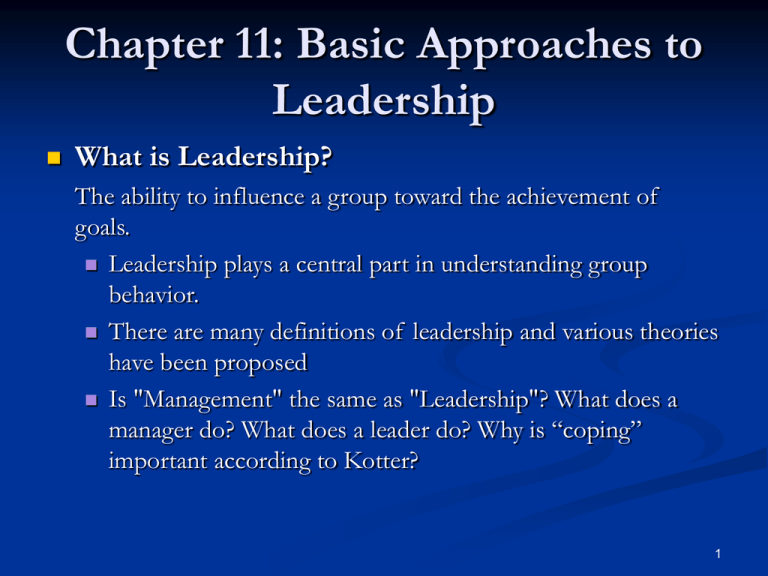
Chapter 11: Basic Approaches to Leadership What is Leadership? The ability to influence a group toward the achievement of goals. Leadership plays a central part in understanding group behavior. There are many definitions of leadership and various theories have been proposed Is "Management" the same as "Leadership"? What does a manager do? What does a leader do? Why is “coping” important according to Kotter? 1 Trait Theories • Theories that consider personal qualities and characteristics that differentiate leaders from nonleaders. • Some traits increase the likelihood of success as a leader, but none of them guarantee success. • Traits predict behavior better in “weak” than “strong” situations. • Unclear evidence of the cause and effect of relationship of leadership and traits. • Better predictor of the appearance of leadership than distinguishing effective and ineffective leaders. 2 Behavioral Theories • Trait theory: Leaders are born, not made. • Behavioral theory: Leadership traits can be taught. 3 Behavioral Theories Ohio State Studies Initiating structure vs. Consideration University of Michigan Studies Employee oriented vs. production oriented The Managerial Grid Concern for people vs. concern for production (i.e. 81 different styles on which a leader's behavior may fall) Scandinavian Studies Effective leaders display “development-oriented behavior” (value experimentation, seeks new ideas, and generates and implements change) 4 Contingency Theories Fiedler Model Effective group performance depends upon the proper match between the leader's style of interacting with subordinates and the degree to which the situation gives control and influence to the leader. Assumes an individual's leadership style is fixed. Identify style via the Least Preferred Co-worker (LPC) scale Leader-member relations Task structure Position power Match leaders and situations 5 Hersey and Blanchard’s Situational Leadership Theory Leader: decreasing need for support and supervision 6 Leader–Member Exchange Theory 7 Path-Goal Theory and LeaderParticipation Model Path-Goal Theory A leader's behavior is acceptable to subordinates insofar as they view it as a source of either immediate or future satisfaction. Directive vs. supportive leadership Leader-Participation Model Provides a set of rules to determine the form and amount of participative decision making in different situations. There are now 12 contingency variables in the latest revision of this model. This model is often too complicated for managers/leaders to actually put into place in organizations. 8 Implications for Managers Leaders usually are the members of an organization who provide the direction toward goal attainment. Re: Traits - Generally speaking, individuals who are ambitious; have high energy, a desire to lead, self-confidence, intelligence, and are flexible are more likely to succeed as leaders than those without these traits. No particular style (behavioral theories) is effective in all situations Contingency models help us better understand leadership. 9 Chapter 12: Contemporary Issues in Leadership Trust A positive expectation that another will not act opportunistically Competence, consistency, loyalty and openness are dimensions of trust You cannot lead others who do not trust you! Reengineering, downsizing, and the use of 'temps' have undermined employee trust in management 10 Three Types of Trust Deterrence Based Trust (based on fear) Knowledge Based Trust (based on predictability over time) Identification Based Trust (based on mutual understanding of wants and needs) 11 Leaders as Shapers of Meaning: Framing Issues Leaders use framing (selectively including or excluding facts) to influence how others see and interpret reality. 12 Charismatic and Transformational Leadership Charismatic Leadership Followers make attributions of heroic or extraordinary leadership abilities when they observe certain behaviors (ex - Martin Luther King and JFK) Are charismatic leaders born or made? Can charisma be a liability? 13 Transactional vs. Transformational Leadership Transactional - leaders who guide or motivate their followers in the direction of established goals by clarifying role and task requirements Transformational - leaders who inspire followers who transcend their own self-interests and who are capable of having a profound and extraordinary effect on followers. 14 Visionary Leadership and Emotional Intelligence Visionary Leadership The ability to create and articulate a realistic, credible, attractive vision of the future for an organization or organizational unit that grows out of and improves upon the present. Key Skills: The ability to explain the vision to others, the ability to express the vision not just verbally but through the leader’s behavior, and the ability to extend the vision to different leadership contexts. 15 Emotional Intelligence Emotional Intelligence (EI) & Leadership Effectiveness EI has 5 key components - which "great" leaders demonstrate: self-awareness self-management self-motivation empathy social skills EI may be added to our list of "traits" of effective leaders 16 Contemporary Leadership Roles Providing Team Leadership Many leaders are not equipped to handle the change to teams. New skills such as the patience to share information, trust others, give up authority, and knowing when to intervene are paramount. Team leaders are liaisons with external constituencies, troubleshooters, conflict managers, and coaches 17 Mentoring & Self-Leadership Mentoring: A senior employee who sponsors and supports a less-experienced employee. Self-Leadership: A set of processes through which individuals control their own behavior. 18 Online Leadership Most research has been conducted with “face-to-face” and “verbal” leadership situations. What about online leadership? There is no “non-verbal” component (you often cannot “read” the other person via email). Instead, the structure of words in digital communications can influence reactions: full sentences, phrases, USING ALL CAPS, formality, importance/urgency, style (emoticons, jargon, abbreviations, etc). Messages can convey trust, status, task directives, or emotional warmth. Writings skills are likely to become an extension of interpersonal skills in the future. 19 Challenges to Leadership Leadership as an Attribution Is leadership merely an attribution that people make about other individuals? Substitutes and Neutralizers to Leadership Some argue that sometimes leaders are not even needed! Sometimes individual, job, and organizational variables can act as substitutes for leadership or neutralize the leader's effect to influence followers (ex = a highly structured task) Finding and Creating Leaders Can we use selection to help? (personality tests, interviews – match to situation) Training (can we train leadership? E.g. trust building, mentoring, situation-analysis skills) 20 Implications for Managers Trust is important - as organizations are less stable, personal trust is key in defining relationships and defining expectations Transformational leaders are in demand. Organizations want leaders with vision and charisma to carry out the visions. Invest in leadership selection and training (and follow up with assessment centers, courses, workshops, rotating job responsibilities, coaching, and mentoring) 21
